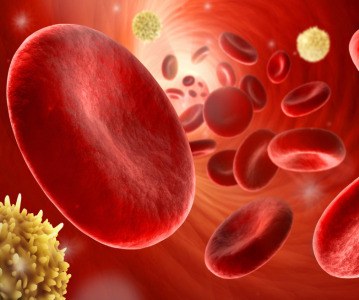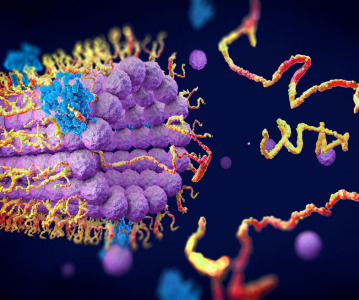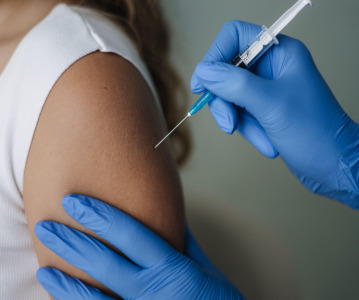Researchers develop microneedle patch for flu vaccination

The patch can dramatically reduce the cost of vaccination, as self-administration can eliminate the need to have health workers oversee the process.
A National Institutes of Health-funded study led by a team at the Georgia Institute of Technology and Emory University has shown that an influenza vaccine can produce robust immune responses and be administered safely with an experimental patch of dissolving microneedles. The method is an alternative to needle-and-syringe immunization; with further development, it could eliminate the discomfort of an injection as well as the inconvenience and expense of visiting a flu clinic.
“This bandage-strip sized patch of painless and dissolvable needles can transform how we get vaccinated,” said Roderic I. Pettigrew, director of the National Institute of Biomedical Imaging and Bioengineering (NIBIB), which funded the study. “A particularly attractive feature is that this vaccination patch could be delivered in the mail and self-administered. In addition, this technology holds promise for delivering other vaccines in the future.”
The researchers received funding through an NIBIB Quantum Grant and from the National Institute of Allergy and Infectious Diseases.
The vaccine patch consists of 100 solid, water-soluble needles that are just long enough to penetrate the skin. “The skin is an immune surveillance organ,” Prausnitz said. “It’s our interface with the outside world, so it’s very well equipped to detect a pathogen and mount an immune response against it.”
Adhesive helps the patch grip the skin during the administration of the vaccine, which is encapsulated in the needles and is released as the needle tips dissolve, within minutes. The patch is peeled away and discarded like a used bandage strip.
The researchers enrolled 100 adult participants, dividing them into four random groups: vaccination with microneedle patch given by a health care provider; vaccination with microneedle patch self-administered by the study participant; vaccination with intramuscular injection given by a health care provider; and placebo microneedle patch given by a health care provider. The researchers used an inactivated influenza vaccine formulated for the 2014-15 flu season to inoculate participants other than those in the placebo group.
The researchers found that vaccination with the microneedle patches was safe, with no serious related adverse events reported. Some participants developed local skin reactions to the patches, described as faint redness and mild itching that lasted 2 to 3 days.
The results also showed that antibody responses generated by the vaccine, as measured through analysis of blood samples, were similar in the groups vaccinated using patches and those receiving intramuscular injection, and these immune responses were still present after 6 months. More than 70% of patch recipients reported they would prefer patch vaccination over injection or intranasal vaccination for future vaccinations.
No significant difference was seen between the doses of vaccine delivered by the health care workers and the volunteers who self-administered the patches, showing that participants were able to correctly self-administer the patch. After vaccination, imaging of the used patches found that the microneedles had dissolved in the skin, suggesting that the used patches could be safely discarded as non-sharps waste. The vaccines remained potent in the patches without refrigeration for at least one year.
The prospective vaccine technology could offer economic and manufacturing advantages. The manufacturing cost for the patch is expected to be competitive with prefilled syringe costs. The patch, however, can dramatically reduce the cost of vaccination, since self-administration can eliminate the need to have health workers oversee the process. It can be easily packaged for transportation, requires no refrigeration, and is stable.
Prausnitz is co-founder of a company that is licensing the microneedle patch technology. He is an inventor on licensed patents and has ownership interest in companies developing microneedle products, including Micron Biomedical. These potential conflicts of interest have been disclosed and are overseen by Georgia Institute of Technology and Emory University.
The team plans to conduct further clinical trials to pursue the technology’s ultimate availability to patients. They also are working to develop microneedle patches for use with other vaccines, including measles, rubella and polio.
The study, published online 27 June 2017, in The Lancet, was led by Nadine Rouphael, associate professor of medicine and Mark J. Mulligan, distinguished professor of medicine, Emory University School of Medicine, in collaboration with Mark R. Prausnitz, Regents Professor and J. Erskine Love Chair in Chemical and Biomolecular Engineering, Georgia Institute of Technology. A team led by Prausnitz designed the dime-sized patch of microneedles used in the study.
Related News
-
News Experimental drug for managing aortic valve stenosis shows promise
The new small molecule drug ataciguat is garnering attention for its potential to manage aortic valve stenosis, which may prevent the need for surgery and significantly improve patient experience. -
News How GLP-1 agonists are reshaping drug delivery innovations
GLP-1 agonist drug products like Ozempic, Wegovy, and Mounjaro have taken the healthcare industry by storm in recent years. Originally conceived as treatment for Type 2 diabetes, the weight-loss effects of these products have taken on unprecedented int... -
News A Day in the Life of a Start-Up Founder and CEO
At CPHI we work to support Start-Up companies in the pharmaceutical industry and recognise the expertise and innovative angles they bring to the field. Through our Start-Up Programme we have gotten to know some of these leaders, and in this Day in the ... -
News Biopharmaceutical manufacturing boost part of new UK government budget
In their national budget announced by the UK Labour Party, biopharmaceutical production and manufacturing are set to receive a significant boost in capital grants through the Life Sciences Innovative Manufacturing Fund (LSIMF). -
News CPHI Podcast Series: The power of proteins in antibody drug development
In the latest episode of the CPHI Podcast Series, Lucy Chard is joined by Thomas Cornell from Abzena to discuss protein engineering for drug design and development. -
News Amgen sues Samsung biologics unit over biosimilar for bone disease
Samsung Bioepis, the biologics unit of Samsung, has been issued a lawsuit brought forth by Amgen over proposed biosimilars of Amgen’s bone drugs Prolia and Xgeva. -
News CPHI Podcast Series: Why we need to consider women in clinical trials
The latest episode of the CPHI Podcast Series with Lucy Chard covers women's health, specifically women's representation in clinical trials, the associated bias, and the impacts on health for this population. -
News US FDA does not approve MDMA therapy for PTSD, requests more data
The MDMA-based therapeutic developed by Lykos Therapeutics, a California-based Public Benefit Corporation (PBC), has been reviewed and unapproved by the US FDA. The regulator has requested additional phase III trial data for further safety and efficacy...
Recently Visited
Position your company at the heart of the global Pharma industry with a CPHI Online membership
-
Your products and solutions visible to thousands of visitors within the largest Pharma marketplace
-
Generate high-quality, engaged leads for your business, all year round
-
Promote your business as the industry’s thought-leader by hosting your reports, brochures and videos within your profile
-
Your company’s profile boosted at all participating CPHI events
-
An easy-to-use platform with a detailed dashboard showing your leads and performance





.png)

.png)